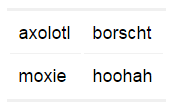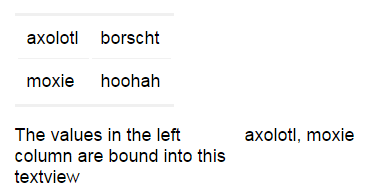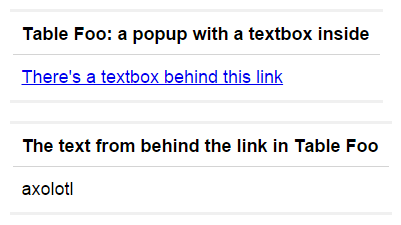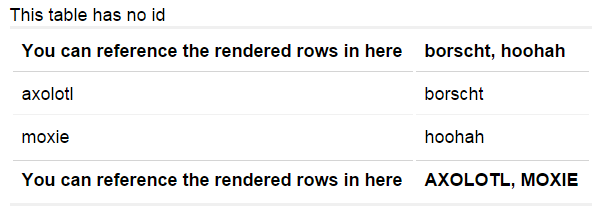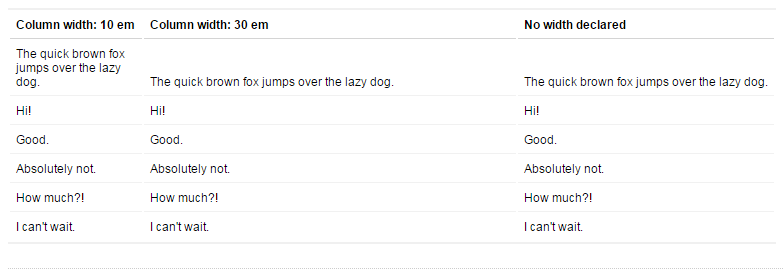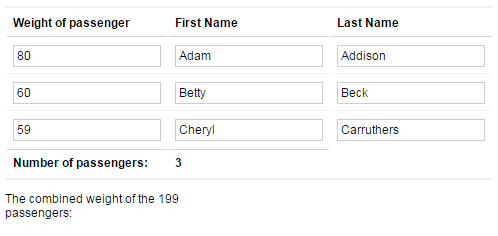Renders a two-dimensional representation of a recordset in your webform based on a row template.
Usage
<table id='id' label='label' recordset='recordset' record='record'> <declarations> declarations </declarations> <validation> validation </validation> <header> header </header> row-template <footer> footer </footer> </table>
Fields
Properties
| Property | Type | Description |
|---|---|---|
| label (read-only) | string |
Specifies the text that will be displayed as the label of the control. |
| recordset (required) | recordset |
A query expression that specifies the source of the tabular data that the table control displays. The recordset that the query expression returns will be rendered in the table control based on the table control's row template. |
| rows (submitted, read-only) | rowset |
The list of all the rows that are rendered in the body of the table control. |
Traits
| Trait | Description |
|---|---|
| declarations |
A collection of zero or more variable declarations (let elements) that can be referenced in solution-wide query expressions. |
| validation |
A collection of zero or more validation rules (validator elements) that evaluate user input in the control at
runtime, and prevent the user from submitting the form if the |
| header | The header row of the rendered table. Exactly one row control child is allowed. |
| row-template (required) | The single row
control used as the template to render the rows in the table control, based on the recordset
that the query in the recordset property returns.
|
| footer | The footer row of the rendered table. Exactly one row control child is allowed. |
Remarks
The query expression in the required recordset property
returns a recordset. For
each row in the returned recordset, an instance of the row template is rendered inside the
table control. There is a built-in iterator variable that you name with the
record field of the table control, that you can use to reference the
elements of the current record. The name that you give the iterator variable in the
record field is an identifier and so must begin with an underscore or a
letter.
Just like any other query expression, the recordset
query is re-evaluated every time its input parameters change. If the re-evaluation modifies
the query's return value, the complete table control, except for its header and footer rows,
is re-rendered, and all changes that the user made in the previously rendered controls are
discarded.
To reference the table control's rendered rows from outside the row template
(either from inside the header or footer or from elsewhere in the solution), use the
rows property in a FROM clause, the same way you would
query a reference table. rows defines a tree structure for the rows, cells,
and controls rendered inside the table
control.
...
<table id="someTable"
recordset='{TABLE random1, random2
("axolotl", borscht;
"moxie", "hoohah")}'
record='n' >
<row>
<cell>
<textview id="textBoo"
text='{n.random1}'/>
</cell>
<cell>
<textview id="textFar"
text='{n.random2}'/>
</cell>
</row>
</table>
<textview
label="The values in the left column
are bound into this textview"
text='{SELECT GROUP_CONCAT(z.textBoo.text, ", ")
FROM someTable.rows z}' />
...
You can traverse the tree structure that rows holds in query expressions
from outside the table control scope to reference any control or its properties. In the
example below, the unnamed bottom table displays the values of the text boxes inside the popup
panels in the tableFoo table using the rows property to
reference the
values.
...
<table id="tableFoo"
recordset='{TABLE random1,
("axolotl")}'
record='r'>
<header>
<row>
<cell>
<textview
text="Table Foo: a popup with a textbox inside"/>
</cell>
</row>
</header>
<row>
<cell>
<popup id="popupBar"
title="There's a textbox behind this link">
<textbox id="textboxBar"
text='{r.random1}'/>
</popup>
</cell>
</row>
</table>
<table recordset='{SELECT q.popupBar.textboxBar.text t
FROM tableFoo.rows q}'
record='target'>
<header>
<row>
<cell>
<textview
text="The text from behind the link in Table Foo"/>
</cell>
</row>
</header>
<row>
<cell>
<textview text='{target.t}'/>
</cell>
</row>
</table>
A header and footer trait is
available in table controls as the first and last child element inside the control,
respectively. You can use these to include a non-template header or footer table row. If you
don't include a header or footer row, the rendered table
control simply won't have one (some of the sample table controls don't).
header and footer rows cannot contain references to the
iterator variable that you name in record, but you can use the
rows property to reference the controls in the rendered table rows.
The id field is optional for table controls, but without an identifier, the
rows property can only be used to reference the rendered rows from within
the table control's header and footer, and not from outside the table control (that is, only
from within the control's own scope).
<table
label='This table has no id'
recordset='{TABLE columnGa, columnBa
("axolotl", "borscht";
"moxie", "hoohah")}'
record='bubble'>
<header>
<row>
<cell>
<textview
text='You can reference the rendered rows in here'/>
</cell>
<cell>
<textview
text='{SELECT GROUP_CONCAT(l.textBar.text, ", ")
FROM rows l}'/>
</cell>
</row>
</header>
<row>
<cell>
<textview id="textFoo"
text='{bubble.columnGa}'/>
</cell>
<cell>
<textview id="textBar"
text='{bubble.columnBa}'/>
</cell>
</row>
<footer>
<row>
<cell>
<textview
text='You can reference the rendered rows in here'/>
</cell>
<cell>
<textview
text='{SELECT UPPER(GROUP_CONCAT(s.textFoo.text, ", "))
FROM rows s}'/>
</cell>
</row>
</footer>
</table>
<!-- You can't use rows
outside the scope of an unnamed table
<textview label="The id-less table
can't be referenced from outside"
text='{SELECT LENGTH(GROUP_CONCAT(c.textFoo.text, ""))
FROM rows c}'/>
-->
...
Use the addbutton and removebutton controls to let the user add rows to or remove rows from a table control, respectively.
width: When you declare a width for a control that is
inside a row template, you set the width for the column that the control is
in.
<form id='wideColumns'
menuName='This table has really wide columns'
platforms='web'
xmlns='http://schemas.mobilengine.com/fls/v1'>
<table id="wideTable"
recordset='{SELECT r.word_series FROM randomWord r}'
record='wide'>
<header>
<row>
<cell>
<textview
text="Column with no width declared"/>
</cell>
<cell>
<textview
text="Column with 50 em width declared"/>
</cell>
</row>
</header>
<row>
<cell>
<textview text='{wide.word_series}'
width='10 em'/>
</cell>
<cell>
<textview text='{wide.word_series}'
width='30 em'/>
</cell>
<cell>
<textview text='{wide.word_series}'/>
</cell>
</row>
</table>
</form>
Figure 258. The same data is bound into each row in the table,
but the cells are of different widths
Sample
<form id='tableControl'
menuName='Table Control Sample'
platforms='web'
xmlns='http://schemas.mobilengine.com/fls/v1'>
<table id="passengers"
recordset='{SELECT p.passenger_id,
p.first_name,
p.last_name
FROM passenger p}'
record='p'>
<header>
<row>
<cell>
<textview text='Passenger ID' />
</cell>
<cell>
<textview text='First Name' />
</cell>
<cell>
<textview text='Last Name' />
</cell>
</row>
</header>
<row>
<cell>
<textbox id='number' text='{p.passenger_id}' />
</cell>
<cell>
<textbox text='{p.first_name}' />
</cell>
<cell>
<textbox text='{p.last_name}' />
</cell>
</row>
<footer>
<row>
<cell>
<textview text='Number of passengers:' />
</cell>
<cell>
<textview text='{TOSTRING((SELECT COUNT(*)
FROM passengers.rows p))}'/>
</cell>
</row>
</footer>
</table>
<textview label='The sum of the passenger IDs:'
text='{TOSTRING((SELECT SUM(TOINT(p.number.text))
FROM passengers.rows p))}'/>
</form>
A
table control with a header and a dynamic
footer, plus a textview that references its
rows.
Only the textbox controls in the Weight of
passenger column have an identifier, so a workflow script running in the
Mobilengine Cloud would access the submission of the webform above in the format
below:
{...
passengers:
{
rows:
[
{number: {text: "80"}},
{number: {text: "60"}},
{number: {text: "59"}}
]
}See the workflow script reference guide for more details on data type mapping.

